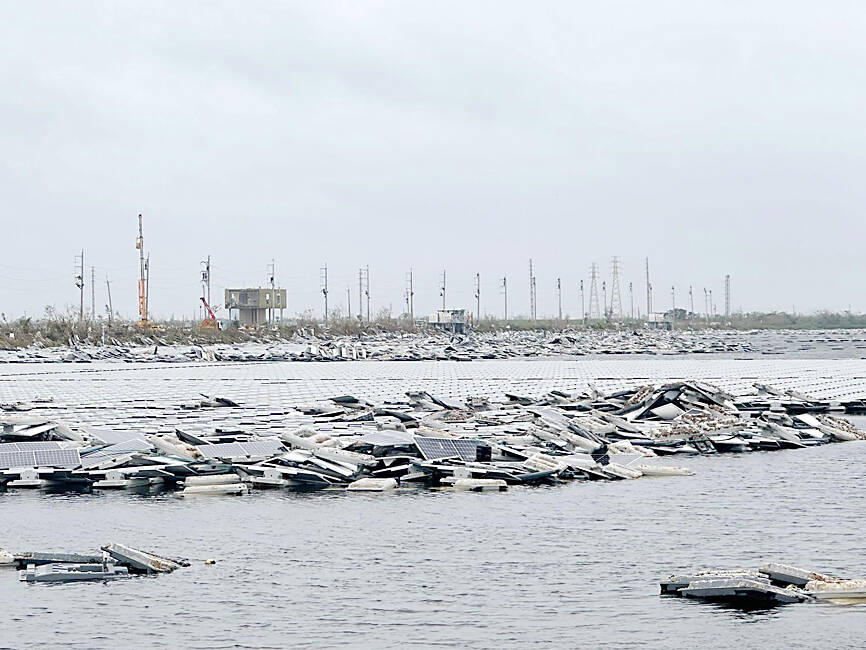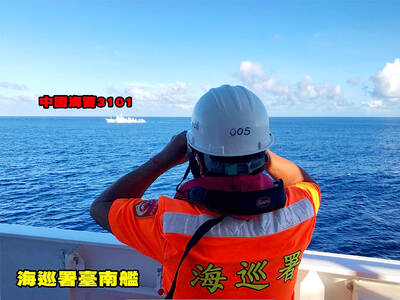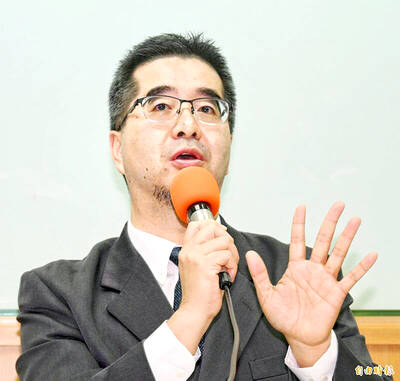A Chinese-language media firm’s “biased” coverage of the Ministry of Environment’s efforts tackling the extensive damage to solar facilities caused by Typhoon Danas was “torture for hardworking public servants,” Minister of Environment Peng Chi-ming (彭?明) said on Friday.
The United Daily News cited misinformation in its mischaracterization of the ministry’s efforts, Peng wrote on Facebook.
About 145,000 solar panels, or 2,800 tonnes of equipment, were destroyed in the typhoon, which made landfall in Chiayi County’s Budai Township (布袋) on July 6, with the debris scattered across ponds and fish farms in Chiayi and Tainan, ministry data showed.

Photo courtesy of Democratic Progressive Party Legislator Tsai Yi-yu via CNA
Peng on Wednesday attended a legislative hearing, at which he answered questions about solar facilities.
An editorial in the United Daily News on Friday cited Peng as saying at the hearing that generator components of solar panels “would not result in any pollution,” as they are sealed with glass and protected by aluminum frames.
However, debris from broken panels might be eaten by fish and reach dinner tables, the editorial said, adding that Peng’s claim that solar facilities cause no pollution was incorrect.
“The Democratic Progressive Party described nuclear waste as something extremely bad, but the total mass of solar panels is tens of thousands of times greater,” it said.
“Do we really have to wait 20 years to realize the horrible truth of solar waste?” it added.
The editorial also accused the ministry of delaying until Monday testing for heavy metal contamination at sites affected by the storm and failing to include floating solar farms in revisions to environmental impact assessment (EIA) regulations in January.
Peng said typhoon-related damage is a challenge posed by extreme weather to energy development.
The unusually powerful gusts brought by the typhoon — reaching 17 on the Beaufort scale — were unforeseeable and snapped cables holding floating solar panels in place, he said, adding that Typhoon Danas was the first to make made landfall in Budai in 120 years of records.
The heavy metal testing of water in affected sites was conducted as scheduled on Monday a week after the typhoon departed, as it was still raining in southern Taiwan the previous week, Peng said.
Elevated levels of manganese were detected in soil and water at the sites, as would be expected, but lead and copper from broken panels does not appear to have gotten into the water, with no lead and only traces of copper — below environmental maximums — were detected, he said.
“I told lawmakers on Wednesday multiple times that ... all manufactured items have an environmental impact ... and every method of generating electricity produces pollutants,” Peng said.
Regarding the criticism over the lack of EIA regulations of floating solar farms, Peng said that the stricter rules prompted complaints from the photovoltaic industry.
However, the ministry is consistent in its environmental standards and would invite opinions on whether EIA requirements for solar facilities should be bolstered.
“Up to 92 percent [of the broken solar panels] are recyclable,” Peng said, adding that the ministry would continue to enhance management of the full life cycle of solar facilities.
Some of the United Daily News’ coverage cited misinformation, some of which was generated by ChatGPT, he said.
“I hope the United Daily News’ management would make progress in training its editors, and choosing content and providing critiques based on scientific facts,” he added.

The Coast Guard Administration (CGA) yesterday said it had deployed patrol vessels to expel a China Coast Guard ship and a Chinese fishing boat near Pratas Island (Dongsha Island, 東沙群島) in the South China Sea. The China Coast Guard vessel was 28 nautical miles (52km) northeast of Pratas at 6:15am on Thursday, approaching the island’s restricted waters, which extend 24 nautical miles from its shoreline, the CGA’s Dongsha-Nansha Branch said in a statement. The Tainan, a 2,000-tonne cutter, was deployed by the CGA to shadow the Chinese ship, which left the area at 2:39pm on Friday, the statement said. At 6:31pm on Friday,

The Chinese People’s Liberation Army Navy’s (PLAN) third aircraft carrier, the Fujian, would pose a steep challenge to Taiwan’s ability to defend itself against a full-scale invasion, a defense expert said yesterday. Institute of National Defense and Security Research analyst Chieh Chung (揭仲) made the comment hours after the PLAN confirmed the carrier recently passed through the Taiwan Strait to conduct “scientific research tests and training missions” in the South China Sea. China has two carriers in operation — the Liaoning and the Shandong — with the Fujian undergoing sea trials. Although the PLAN needs time to train the Fujian’s air wing and

Taiwanese celebrities Hank Chen (陳漢典) and Lulu Huang (黃路梓茵) announced yesterday that they are planning to marry. Huang announced and posted photos of their engagement to her social media pages yesterday morning, joking that the pair were not just doing marketing for a new show, but “really getting married.” “We’ve decided to spend all of our future happy and hilarious moments together,” she wrote. The announcement, which was later confirmed by the talent agency they share, appeared to come as a surprise even to those around them, with veteran TV host Jacky Wu (吳宗憲) saying he was “totally taken aback” by the news. Huang,

The American Institute in Taiwan (AIT) put Taiwan in danger, Ma Ying-jeou Foundation director Hsiao Hsu-tsen (蕭旭岑) said yesterday, hours after the de facto US embassy said that Beijing had misinterpreted World War II-era documents to isolate Taiwan. The AIT’s comments harmed the Republic of China’s (ROC) national interests and contradicted a part of the “six assurances” stipulating that the US would not change its official position on Taiwan’s sovereignty, Hsiao said. The “six assurances,” which were given by then-US president Ronald Reagan to Taiwan in 1982, say that Washington would not set a date for ending arm sales to Taiwan, consult